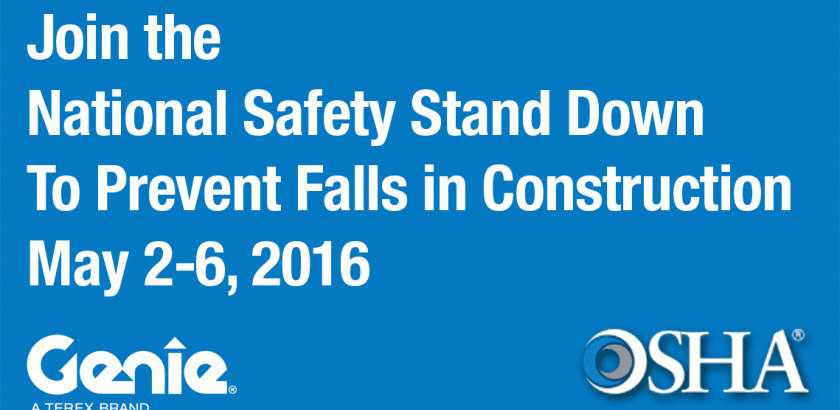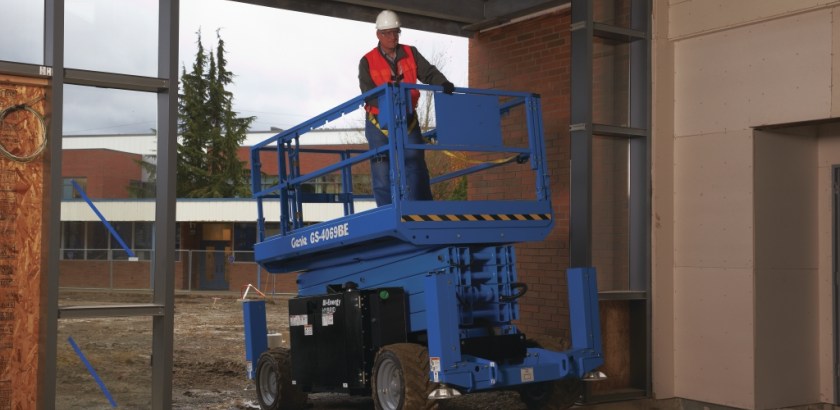OSHA Issues “Working Safely with Scissor Lifts” Alert
by Marie Engstrom - Product Manager On Mar 10, 2016, 03:00 AM
Subscribe To Aerial Pros
Filter by tags
The U.S. Occupational Safety and Health Administration (OSHA) has released an updated hazard alert that highlights specific hazards present in workplaces where scissor lifts are used, and defines specific controls employers must implement to prevent incidents. Below are excerpts from this important OSHA alert; the entire alert can be downloaded via this link: Working Safely with Scissors Lifts.
According to OSHA, employers are responsible for keeping workers safe when using scissor lifts and must comply with the agency’s 29 CFR standards, including attention to Fall Protection, Stabilization, Positioning, Maintaining and Training Workers.
 Fall Protection
Fall Protection
Scissor lifts must have guardrails installed to prevent workers from falling (see 29 CFR 1926.451(g) or 29 CFR 1910.29(a)(3)(vii)). Employers should train workers to:
- Check to see that a guardrail system is in place before working on the scissor lift.
- Only stand on the work platform; never stand on the guardrails.
- Keep work within easy reach to avoid leaning away from the scissor lift.
Stabilization
Employers should ensure that scissor lifts are stable and will not tip over or collapse. Some safe work practices to ensure safe, stable conditions for scissor lift use include:
- Follow the manufacturer’s instructions for safe movement.
- Select work locations with firm, level surfaces away from hazards.
- Use the scissor lift outside only when weather conditions are good, generally limited to wind speeds below 28 miles per hour.
Positioning
Positioning the scissor lift to avoid crushing hazards is important for safe use. Scissor lifts present crushing hazards similar to vehicles and other mobile equipment at worksites. Employers should train workers to be watchful when:
- A moving scissor lift is near a fixed object.
- A moving vehicle and the scissor lift are operating closely.
- The scissor lift passes under a fixed object, such as a door frame or a support beam.
- Positioning the scissor lift to avoid electrocution, arc flash, and thermal burns is important for safely using scissor lifts near energized power lines. Since electricity can arc or jump from the power line to the scissor lift or worker, electrocution can occur even if neither the scissor lift nor the worker touches the power line.
Maintaining Scissor Lifts
Employers must regularly maintain scissor lifts to ensure that they are safe to use (e.g., prevent the lifting mechanism from collapsing). Manufacturer’s maintenance and inspection instructions will generally include how to:
- Test and inspect controls and components before each use.
- Ensure that guardrail systems are in good working condition.
- Verify that brakes once set will hold the scissor lift in position.
Training Workers
Employers must provide workers training on hazards, including how to work safely with or near scissor lifts. (29 CFR 1926.454). Training must, at a minimum, include:
- Manufacturer’s instructions for operating the scissor lift vertically and while in transit.
- How to handle materials on the scissor lift, including weight limits.
- Other worksite hazards workers may encounter when working on a scissor lift (e.g., contact with electrical wires).
- Reporting any equipment defects or maintenance needs.
 Genie applauds OSHA’s efforts to communicate employer’s responsibilities in keeping workers safe with their scissor lift hazard alert. Safety training is a critical part (as is maintenance, jobsite hazard assessments, machine selection and more) in helping to ensure that scissor lift operators are kept safe. Safety does not need to be complicated, but it does need to be taken seriously each and every time a piece of equipment is used. We believe with a few simple steps, operators can be educated and trained to operate scissor lifts, as well as other aerial work platforms, safely and efficiently in a wide variety of applications. Genie takes safety seriously, and while OSHA offers to help with compliance assistance, Genie is also there for support.
Genie applauds OSHA’s efforts to communicate employer’s responsibilities in keeping workers safe with their scissor lift hazard alert. Safety training is a critical part (as is maintenance, jobsite hazard assessments, machine selection and more) in helping to ensure that scissor lift operators are kept safe. Safety does not need to be complicated, but it does need to be taken seriously each and every time a piece of equipment is used. We believe with a few simple steps, operators can be educated and trained to operate scissor lifts, as well as other aerial work platforms, safely and efficiently in a wide variety of applications. Genie takes safety seriously, and while OSHA offers to help with compliance assistance, Genie is also there for support.
If you have any questions regarding scissor lift product safety, this OSHA alert or any other scissor lift-related topics, please feel free to contact us anytime at 800-536-1800.
For more information on operator safety training for scissor lifts, please contact us at AWP.Training@Terex.com.
Related Posts

Lift Pro Online Product Training: Intro to Genie Scissor Lifts
Learn more about the Genie Scissor Lifts through this 15 minute interactive presentation
Continue Reading

Genie Joins OSHA’s National Safety Stand-Down Efforts to Raise Safety Awareness
Safety is at the core of the Genie culture, and we want it to be at the core of your company culture too.
Continue Reading

Genie Joins OSHA’s National Fall Prevention Stand-Down Efforts
The number one priority on any aerial jobsite should be to promote a safe workplace for both the operators and the people around them.
Continue Reading


